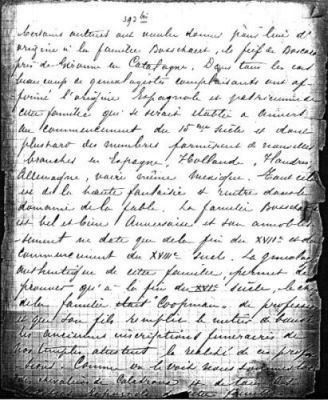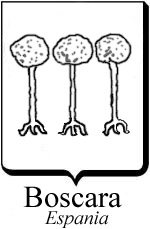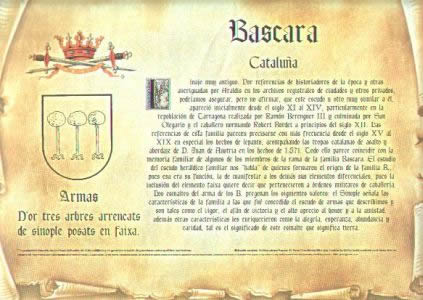|
|
Bosschaerts - Persyn Genealogical research - Earliest Traces
|
Boscara
A tale
is told, that between 1300 and 1400 the counts of Boscara in Spain established
themselves in the southern part of The Netherlands. The reason for its arrival
has remained unknown. They possibly arrived to fight or trade. Anyway the name
Boscara would soon be assimilated to the Dutch dialect.
We cannot verify
this tale. Anton Bosschaert asked a question to the government of Bascara in the
province of Gerona and received an exhaustively report. Hereby a translation
of this report:
"The place
Báscara can also be named Boscara. The difference doesn't matter. Its
name is Báscara, but historical writers may have adapted the name.
That is why the difference doesn't matter.
People assume, that Báscara is the old Deciana that occurs on the cards
of Ptolemeus. In the will of Pedro the Castellnou, bishop of Gerona, it is
named as Sancti Accicli the Baschera. In a description of an alodium anno
1140 by Ermengardis for the diocees of Gerona, the city is also called Sancti
Aciscli the Baschera.
It is difficult to verify if a feudal has travelled from Báscara to
the (current) Belgium between the years 1200 and 1550. He even might have
accompanied Karel V. (Observation: it is almost impossible that the requested
noble man belonged to the consequence of Karel V: you have to search in a
much former period.) During that period several counts of Ampurias and bishops
of Gerona have paraded through the streets of Báscara. Báscara
was reighned by Pedro III the Great and Pedro IV the Holy.
Between 7 and 12 October 1466 Queen Juana Enríquez, the mother of Fernando
the Catholic, took back the area under her sovereignty, during the civil war
against the throne applicant Renato de Anjou. The bishop Arnaldo de Montrodó
and his retinue have left Báscara in 1341, because of a banishment
based on the shameful extortions of his subjects and because of his interference
in the plans of the king of Mallorca. They were hunted, as a punishment that
was applicable for criminals.
A lot of noble men claimed a religious or notorious office, and also soldiers
and Catalans lived in the castle.
Pedro and Ramon de Gallinés, father and son from the house of Gallinés,
established themselves in 1326 in Báscara. The son was captured for
a personal reason in the castle of Sobreporta in the city Gerona. In these
years we find the names of the noble men:Zafont, Cella, Tafurer, Crosas, etc.
and later: Ferrer, Vila, García the Oñate, the Miguel, etc.
While Báscara were a feudality of the diocese of Gerona we know a lot
of feudal lords: (Hereafter a table with names from 1196 until 1554. This
table does not contain the name Bosschaert nor any possible derivative names).
One cannot discover an agreement in coats-of arms of Bosschaert and Báscara.
Two heraldic weapons excisted, but they were chopped away as a sentence for
the crime of betrayal against Philips V during the succession-war. These coats-of-arms
were of partisans of the archduke."
 |
In the Antwerp
city-archive a file of 'Bisschops and de Donnet' contains a French
text, from un unknown author. Hereby the found document and the English translation:
"Certain authors have wanted to link a tribe father to the family of Bosschaert
who was a feodal lord in Boscara, feodality of Gironne and Catalagne.
Most genealogists will have confirmed this Spanish origin. This family
will have established themself at the beginning of the 15th century
in Antwerp. Afterwards several tribes have arisen with branches in
Spain, the Netherlands, Flanders, Germany and even Mexico.
All this is however based on a fantasy and must be reffered to as
a tale. The family Bosschaert is thorough of the Antwerp origin and
its nobility dates from the 17th and 18th century. The valid genealogy
of this family indicates at the end of the 16th century a tribe father
as a 'coopman' (merchant) and his son was a 'vleeshouwer' (butcher).
Others try to prove our ancestors were 'chevaliers de Calatrova' (knight
of Calatova) and 'hidalgos Espagnol ' (of a Spanish origin)".
A critical
reader must conclude that this sincere indignation is slightly out
of place. One categorical negative letter cannot erase the reality.
And that reality is, that we do not know the truth. There is absolutely
no starting point.
|
 |
On a Spanish document Anthony has found a heraldic clue:
The coat-or-arms of Báscara or Boscara as tree
uprooted trees of gold on a green field.
This coat-or-arms appears in the 11th century and is carried in the
14th century in Tarragona by Ramon Berenguer, San Olegario and also
in the beginning of the 12th century by the Norwegian knight Robert
Bordet.
The Bascara's fought with the Catalan fightertroups in Lepanto at the
command of Don Juan of Austria.
In Antwerp we have found similar coat-of-arms: always three (arid or
uprooted) trees, surrounded with 3 lapwings of blackbirds. The number
'3' might also mean something.
|

The
author E. de Steins of "Universel, Panthéon Biographique" (1850)
assumpts that Guillaume Bouschaert, originating of Boscara (in Spain, not far
from Gerona in Catalonia), was married with Giacomelle de Neufville. His (grand)grandchild
established as an alderman in Antwerp.
Link to this genealogy
And thus starts E. de
Steins the Bosschaert genealogy. This seems a rather improbable theory, but
yet it cannot be refuted.
In "Nobiliaire the Belgique" by Van der Heijden this theory is reused
and ‘corrected’; also without any source indication. The (grand)grandchild
Jacobus was then married with Lysbeth van Haubraecken.
The analogy between Boscara, Bouschart and Bosschaert is easy:
original pronounced in Spain as Bouschart and written in the Netherlands or
Flanders as Bosschaert.
The writings of the 'Bisschops and de Donnet', town archivists of the city of
Antwerp, also mention Lysbeth van HAUBRAKEN, but she was married with Wouter,
son of Diericx. Jacobus is the son of Wouter. We consider this latter theory
as probably correct. Bisschops and de Donnet do not mention a Spanish Lord of Boscara.
|
|








